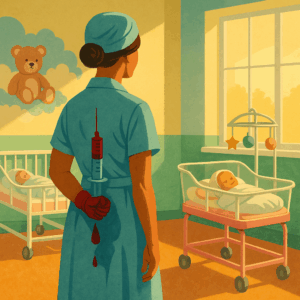They called it the “soft room,” that neonatal ICU bathed in pastel colors where preemies were supposed to grab their first fragile breaths. Instead, from the summer of 2015 through the summer of 2016, the Countess of Chester Hospital in northern England became a house of horrors, and the quiet nurse everybody nicknamed “Letby Lullaby” was right in the middle of every code blue. Make no mistake – Lucy Letby “nurse killer” now stands shoulder-to-shoulder with Charles Cullen, “The Good Nurse,” and Beverly Allitt, the dreaded “Angel of Death,” in the black ledger of medical murderers, and the body-count math is chilling: seven murdered babies, eight others left fighting for their lives, and fifteen whole-life sentences that guarantee she’ll never again see daylight without razor wire

It started with whispers among the unit’s veteran docs. Healthy preemies would crash without warning, bellies blown up with air, insulin levels rocketing for no clinical reason, or tiny livers ruptured like over-ripe plums. Every time, the staffing roster had the same name penciled in: L. Letby. Consultants flagged it, demanded she be benched, begged admin to call the cops. Management – terrified of a PR bloodbath – sent polite emails, shuffled schedules, and basically told everyone to keep calm and carry on. That paralysis bought the killer more time and, prosecutors say, cost at least five infants their lives. The decision-making is now under criminal investigation for potential corporate manslaughter
When detectives finally kicked in her front door in 2018, they found a trove that felt ripped from a Netflix scriptwriter’s corkboard: a Post-it that read “I AM EVIL I DID THIS,” screenshots of late-night Facebook searches for grieving parents, and diaries tracking every collapse like twisted trophies. But the crown jewel for the prosecution was a brutal piece of math – an actuarial “shift chart” showing that the chance of one nurse being present at so many fatal events was one in two septillion. Even Letby’s own colleagues gasped when the graphic hit the courtroom monitors
The trial that followed in Manchester was the longest for a woman in modern U.K. history. Jurors sat through ten months of forensic jawbreakers: pedi-pathologists explaining air emboli, IT folks parsing swipe-card data that the Crown Prosecution Service later admitted had been mislabeled, and parents reliving the moment a routine feed turned into a funeral. In August 2023 the jury came back – guilty on all counts except one unresolved attempt. Judge James Goss, refusing to sugar-coat, slapped her with a whole-life order, the harshest penalty on the books. Letby ghosted her own sentencing, forcing heart-broken families to address an empty dock
Fast-forward to July 2024: prosecutors hauled her back for a do-over on “Baby K,” the lone holdout. Same courtroom, shorter trial, same verdict – guilty. Another whole-life sentence stacked on the pile. Within weeks her lawyers filed appeal papers claiming prejudicial publicity and flawed statistics; the Court of Appeal shot them down in a single paragraph. She’s now banking on a long-shot bid to the Criminal Cases Review Commission, backed by an international neonatology panel that says the science is shaky. The Guardian quipped it could become Britain’s “Serial”-style debate if it gains traction
Meanwhile, the supporting cast is feeling the heat. Three senior hospital bosses were cuffed on suspicion of gross-negligence manslaughter. A married consultant – the doctor Letby texted 1,300 times and allegedly called “her rock” – is under probe for supplying her with confidential baby charts after hours. Internal emails show execs weighed brand damage before patient safety; Lady Justice Thirlwall’s public inquiry, once slated to wrap by late 2025, now says early 2026 thanks to the avalanche of new docs.
The why of it all remains a black hole. Prosecutors floated Munchausen-by-proxy, ego-driven hero syndrome, even a craving for male attention. Forensic shrinks counter that none of that squares with her painfully ordinary backstory: middle-class upbringing, pet-loving, scrapbooking, the works. What’s undeniable is the pattern – kill, then hang around the parents like a grief counselor, sometimes snapping photos for the memory box. Colleagues recall Lucy Letby “nurse killer” returning from the code room dry-eyed, asking, “Anyone want a coffee?” while alarms were still echoing.
On the policy front, Britain is scrambling to harden its hospitals. Real-time mortality dashboards are being rolled out so statisticians can spot lethal outliers before body bags pile up. Parliament is debating a law to force convicts to attend sentencing after Letby’s no-show. And whistle-blowers are finally getting the airtime they were denied back in 2016. Chester’s consultants, once branded troublemakers, are now testifying at Westminster about being gas-lit by their own C-suite
As for Lucy Letby “nurse killer”, she’s locked down at HMP Bronzefield, a high-security women’s prison outside London. Inmates reportedly taunt her with lullabies during headcount. Guards say she keeps to herself, volunteers in the library, and obsessively files paperwork. She’ll be pushing 80 when the Thirlwall report drops; if the findings blow open the case, she’ll still be behind bars awaiting depositions. That’s the brutal symmetry of a whole-life order – you can challenge the conviction till the sun burns out, but you’re not walking through the gate
So where does that leave the rest of us? In a grim lesson that credentials and bedside smiles aren’t enough, that spreadsheets can catch killers, and that hospitals must choose transparency over bruised egos. The Countess of Chester’s ICU once whispered with ventilators and lullabies; now it screams a warning that echoes across every NICU on the planet. Keep the cameras rolling, the stats crunching, and the whistle-blowers talking – because another Lucy Letby is always one shift away.
Leave a Reply